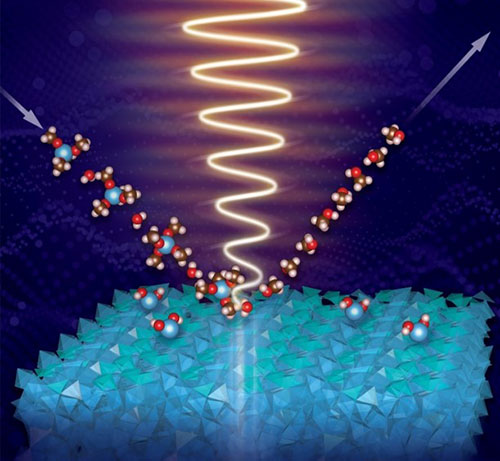Watch-and-Learn How Nanostructured Thin-Films Grow
February 24, 2021
 enlarge
enlarge
Illustration of incoming precursor molecules reacting to grow titania, with residual molecules swept away. The growth process takes place under illumination by X-rays, which allow real-time observation of the process.
What is the scientific achievement?
By continuously collecting X-ray absorption spectra during atomically-precise film growth, CFN and NSLS-II researchers discovered a new mechanism for how titanium oxide thin films grow on complex, 3D nanoarchitectures. The team developed data analysis tools to deduce a new picture of growth—involving a prenucleation stage, a transition region, and steady state growth—by atomic layer deposition. Loosely-networked titanium polyhedra are present at the surface and interface regions throughout growth.
Why does this achievement matter?
The in situ, X-ray spectroscopy techniques and data analytics methodologies developed in this work are a powerful toolset for understanding & improving vapor-phase film growth, with benefits for microelectronics, catalysis, and solar energy.
What are the details?
In situ synchrotron X-ray absorption near edge structure characterization of thin-film titania growth by atomic layer deposition (ALD) over zinc oxide (ZnO) nanowires reveals persistent low-coordinated Ti motifs, leading to a new picture of ALD growth. Through design of the growth and measurement cycles, Ti K-edge spectral data are continuously recorded to characterize the film evolution as a function of ALD cycle number and the surface changes within the time scale of the ALD cycle. A unified set of analysis tools are developed to interpret the time series of spectral data. The data revealed a growth sequence starting with an approximately linear prenucleation stage, evolving to a non-linear transition stage, and ending with a steady-state, linear ALD growth stage. The bulk film component tracks the stages of growth. The surface and interface component, present throughout the stages of the growth, reveals a significant coverage of relatively isolated or loosely networked tetrahedrally-coordinated Ti atomic motifs. Finally, spectral signatures for the intra-cycle growth kinetics are reconstructed at a time resolution of ~ 1 s and demonstrate that transient Ti motifs on the growing surface stabilize within a few seconds of the Ti precursor pulse.
CFN Capabilities
CFN Theory & Computation, Materials Synthesis & Characterization, and Electron Microscopy Facilities and NSLS-II ISS and BMM beamlines were used for this study.
Publication Reference
X. H. Qu, D. H. Yan, R. S. Li, J. J. Cen, C. Y. Zhou, W. R. Zhang, D. Y. Lu, K. Attenkofer, D. J. Stacchiola, M. S. Hybertsen, E. Stavitski, M. Z. Liu, Resolving the evolution of atomic layer deposited thin film growth by continuous in situ X-ray absorption spectroscopy, Chemistry of Materials (2021).
DOI: 10.1021/acs.chemmater.0c04547
https://doi.org/10.1021/acs.chemmater.0c04547
Acknowledgement of Support
This research was carried out at Brookhaven National Laboratory (BNL) under Contract No. DE-SC0012704 where facilities used included those of the Center for Functional Nanomaterials (CFN) and 8-ID ISS (Inner Shell Spectroscopy) and 6-BM (BMM) beamlines in the National Synchrotron Light Source II, U.S. Department of Energy Office of Science User Facilities. This work used the computational resource of the Scientific Data and Computing Center, a component of the Computational Science Initiative at BNL. R. S. Li is supported by BNL LDRD Project No. 19-008.
2021-18729 | INT/EXT | Newsroom









